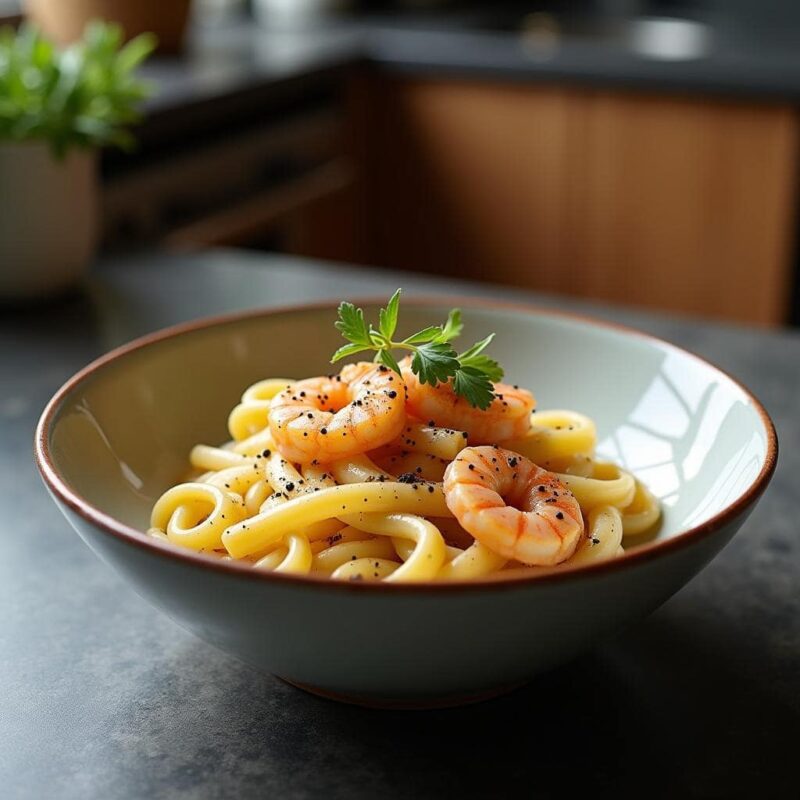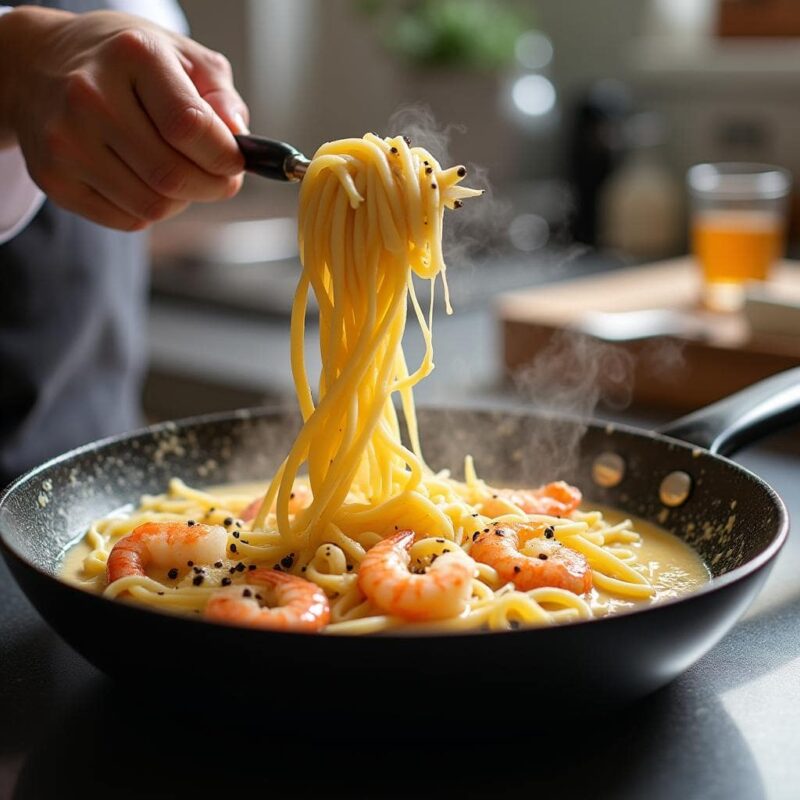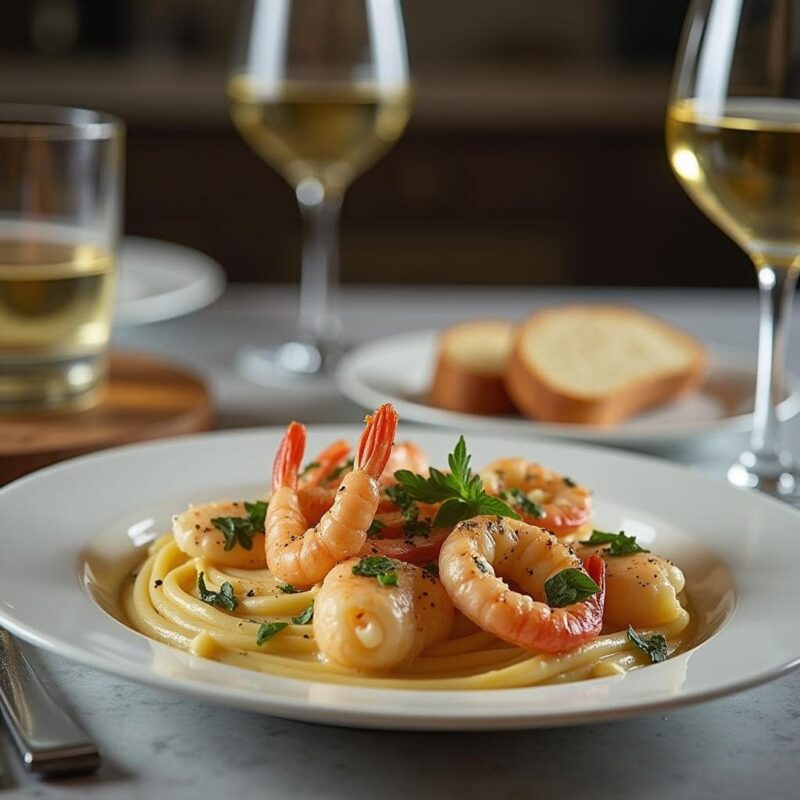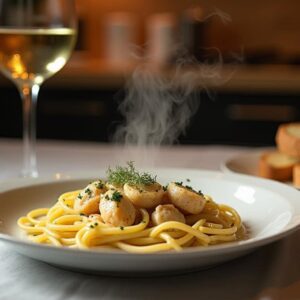Introduction

Cacio e Pepe is one of Rome’s most beloved pasta dishes. Simple yet full of flavor, this classic recipe consists of just three key ingredients: pasta, Pecorino Romano cheese, and black pepper. But what happens when we take this traditional dish and give it a seafood twist? Enter Seafood Cacio e Pepe, a delicious variation that brings together the creamy, peppery goodness of the original with the delicate flavors of fresh seafood.
In this guide, we’ll explore the history of Cacio e Pepe, why seafood is a fantastic addition, and how to select the best ingredients to make this dish shine. Whether you’re a seasoned home cook or a beginner in the kitchen, this step-by-step guide will help you create a restaurant-worthy meal right at home.
History of Cacio e Pepe
Origins in Roman Cuisine
Cacio e Pepe, which translates to “cheese and pepper,” has deep roots in Roman history. It originated as a meal for shepherds who needed something simple, filling, and easy to prepare. The ingredients—dried pasta, aged Pecorino Romano cheese, and black pepper—were all non-perishable, making them perfect for long journeys through the countryside.
Over time, Cacio e Pepe became a staple in Roman trattorias and eventually gained worldwide fame. Its creamy, rich texture, created without the need for butter or cream, showcases the beauty of simple ingredients working in harmony. If you’re a fan of Mediterranean flavors, you might also enjoy dishes like this Spanish Seafood Paella Recipe, which brings together fresh seafood and bold spices.
Traditional Ingredients and Preparation
The magic of Cacio e Pepe lies in its technique. Instead of using heavy cream, the starch from the pasta water helps emulsify the cheese, creating a velvety sauce. The key ingredients include:
- Pasta: Traditionally, tonnarelli is used, but spaghetti or bucatini work well too.
- Pecorino Romano: A sharp, salty sheep’s milk cheese that defines the dish’s signature flavor.
- Black pepper: Freshly cracked pepper is essential, adding warmth and depth.
This dish is all about balance—coating the pasta evenly without clumping the cheese or overpowering the delicate flavors with too much pepper.
The Fusion of Seafood and Cacio e Pepe
How Seafood Enhances the Classic Dish
Adding seafood to Cacio e Pepe creates a whole new level of flavor. The natural sweetness of shellfish or flaky fish beautifully contrasts the salty, tangy Pecorino Romano. The briny notes from seafood also enhance the depth of the dish, making it feel fresh and luxurious.
Seafood’s tender texture pairs wonderfully with the creamy sauce, offering a delightful balance between richness and lightness. Moreover, seafood is packed with protein and healthy fats, making this dish both indulgent and nutritious. If you love seafood-forward dishes, check out this Mediterranean Black Bean Salad for a fresh and healthy side option.
Popular Seafood Choices for This Recipe
When selecting seafood for Cacio e Pepe, it’s important to choose varieties that complement the cheese and pepper without overwhelming them. Some great options include:
- Shrimp: Sweet and tender, shrimp cook quickly and absorb flavors well.
- Scallops: Their delicate, buttery texture adds a refined touch.
- Lobster: A more luxurious choice, lobster’s natural sweetness pairs beautifully with Pecorino Romano.
- Clams or Mussels: These shellfish introduce a briny, umami depth to the dish.
- White Fish (Cod, Halibut, or Sea Bass): Mild and flaky, these fish varieties don’t overpower the sauce.
Whether you choose one type or a mix, seafood adds an elegant twist to this Roman classic.
Selecting the Right Seafood
Fresh vs. Frozen: Pros and Cons
Choosing the best seafood is key to making this dish shine. Here’s a quick comparison of fresh and frozen seafood:
| Type | Pros | Cons |
|---|---|---|
| Fresh Seafood | Best flavor, ideal texture | More expensive, shorter shelf life |
| Frozen Seafood | Convenient, often frozen at peak freshness, more affordable | May have slightly different texture |
If you’re using frozen seafood, make sure to thaw it properly by placing it in the refrigerator overnight. Avoid defrosting in hot water, as it can make the seafood rubbery.
Sustainable Seafood Options
Sustainability is important when selecting seafood. Overfishing and harmful fishing practices can negatively impact marine ecosystems. Look for certifications like:
- MSC (Marine Stewardship Council): Ensures sustainable fishing practices.
- ASC (Aquaculture Stewardship Council): Focuses on responsible seafood farming.
- Seafood Watch (by Monterey Bay Aquarium): Offers recommendations on eco-friendly choices.
Opt for wild-caught shrimp, sustainably farmed scallops, or locally sourced shellfish to make a responsible and delicious meal. If you’re interested in learning more about sustainable Mediterranean cuisine, you might enjoy this article on Tunisian Couscous: History & Culture.
Tips for Purchasing Quality Seafood
- Look for Clear Eyes and Bright Flesh: If buying whole fish, clear eyes indicate freshness.
- Avoid Fishy Smells: Fresh seafood should smell like the ocean, not overly “fishy.”
- Check for Firm Texture: Press the seafood lightly—it should bounce back, not feel mushy.
- Read Labels: When buying frozen, check for “flash-frozen” or “wild-caught” labels.
A high-quality seafood selection makes all the difference in flavor and texture.
Ingredients Needed
Detailed List of Ingredients
To make the perfect Seafood Cacio e Pepe, you’ll need:
For the Pasta:
- 12 oz spaghetti, bucatini, or tonnarelli
- 1 cup reserved pasta water (essential for sauce consistency)
For the Sauce:
- 1 ½ cups Pecorino Romano cheese, finely grated
- 2 teaspoons freshly ground black pepper
- 2 tablespoons olive oil or butter (optional, for extra richness)
For the Seafood:
- ½ pound shrimp, peeled and deveined
- ½ pound scallops or a mix of clams and mussels
- 2 cloves garlic, minced (adds depth without overpowering)
- 1 tablespoon lemon juice (enhances freshness)
- 1 tablespoon chopped parsley (for garnish)
Importance of Each Component in the Dish
Each ingredient plays a vital role:
- Pasta: The foundation of the dish—choose a variety that holds sauce well.
- Cheese: Pecorino Romano creates the creamy texture without cream.
- Black Pepper: Adds warmth and a slight bite, balancing the richness.
- Seafood: Brings sweetness and umami, complementing the salty cheese.
- Garlic & Lemon: Elevate flavors without overshadowing the classic elements.
- Pasta Water: The secret ingredient that emulsifies everything into a smooth, velvety sauce.
Now that we’ve covered the history, ingredient selection, and preparation essentials, let’s move on to cooking this dish to perfection!
Step-by-Step Preparation Guide
Now that we have all the ingredients ready, it’s time to bring this dish to life. Follow these steps to ensure your Seafood Cacio e Pepe turns out creamy, flavorful, and perfectly balanced.
1. Preparing the Seafood
- If using shrimp or scallops: Pat them dry with a paper towel to remove excess moisture. This helps them sear properly and develop a nice golden crust.
- If using clams or mussels: Soak them in cold water for about 20 minutes to remove any sand. Scrub the shells and discard any that are already open.
- Season lightly: A pinch of salt and a dash of lemon juice enhance the natural sweetness of the seafood.
Cooking the Seafood:
- Heat a tablespoon of olive oil in a large skillet over medium-high heat.
- Add the shrimp and scallops, searing for about 2 minutes per side until they turn opaque. Remove and set aside.
- If using clams or mussels, add them to the pan with ¼ cup of white wine and cover. Let them steam for about 5 minutes or until they open. Discard any that remain closed.
- Once cooked, keep the seafood warm while preparing the pasta and sauce.
2. Cooking the Pasta to Al Dente
Cooking the pasta correctly is essential for a perfect Cacio e Pepe. Follow these steps:
- Bring a large pot of salted water to a boil. (Use about 1 tablespoon of salt per liter of water.)
- Add the pasta and cook 1-2 minutes less than the package instructions (al dente means it should still have a slight bite).
- Before draining, scoop out 1 cup of pasta water—this will be used to make the sauce silky and smooth.
- Drain the pasta but do not rinse it, as the starch helps with sauce absorption.
If you love simple pasta dishes with bold flavors, you might also enjoy this Spinach and Linguine Recipe.
3. Creating the Cheese and Pepper Sauce
This step is the heart of Cacio e Pepe, where magic happens. The key is emulsification—using hot pasta water to melt the cheese into a smooth sauce.
- In a large pan, toast the freshly ground black pepper over medium heat for about 30 seconds. This releases its natural oils and enhances the aroma.
- Lower the heat and add ½ cup of reserved pasta water, letting it simmer.
- In a mixing bowl, combine the grated Pecorino Romano with a few tablespoons of warm pasta water, stirring to form a paste.
- Add the cooked pasta to the pan with black pepper, tossing well.
- Remove from heat and slowly mix in the cheese paste, stirring continuously to avoid clumping. Add more pasta water as needed to achieve a creamy, smooth sauce.
4. Combining All Elements for the Final Dish

Now it’s time to bring everything together!
- Gently fold in the cooked seafood, ensuring it is evenly coated with the sauce.
- Add another sprinkle of black pepper and Pecorino Romano for extra flavor.
- Garnish with chopped parsley and a squeeze of lemon juice to enhance freshness.
- Serve immediately, as the sauce thickens quickly as it cools.
Tips for Perfecting the Dish
Want to make sure your Seafood Cacio e Pepe turns out restaurant-quality? Follow these expert tips:
Achieving the Ideal Sauce Consistency
- Use warm pasta water: Hot water helps emulsify the cheese, while cold water causes clumps.
- Add cheese off the heat: Mixing cheese over high heat can make it stringy instead of creamy.
- Toss constantly: Stirring and tossing the pasta thoroughly helps coat every strand evenly.
Balancing Flavors: Cheese, Pepper, and Seafood
- Don’t oversalt the pasta water—Pecorino Romano is already quite salty.
- Use freshly ground black pepper for a deep, aromatic flavor.
- Pair seafood wisely—mild options like shrimp and scallops blend well, while overly strong fish may overpower the dish.
Common Mistakes to Avoid
- Skipping the pasta water: This is crucial for a smooth sauce.
- Overcooking seafood: Shrimp and scallops cook quickly; overcooking makes them rubbery.
- Using pre-shredded cheese: It often contains anti-caking agents that prevent it from melting properly. Always grate cheese fresh.
Variations and Substitutions
Not a fan of certain seafood? Need a dairy-free option? Here are some creative ways to adapt the dish:
Alternative Seafood Options
- Crab Meat: Adds a rich, slightly sweet flavor.
- Squid or Calamari: Offers a chewy but tender texture.
- Salmon: Flaky and full of healthy fats, though its bold taste might slightly overpower the cheese.
Vegetarian and Vegan Adaptations
Want a seafood-free version? Try these:
- Mushroom Cacio e Pepe: Sautéed mushrooms add an earthy, umami depth.
- Zucchini or Artichokes: Lightly roasted vegetables provide texture and freshness.
- Vegan Cheese Substitute: Use a mix of cashew-based cheese and nutritional yeast for a plant-based twist.
Gluten-Free Pasta Choices
For a gluten-free version, swap traditional pasta for:
- Chickpea Pasta: High in protein, with a slightly nutty taste.
- Rice Noodles: A lighter option, though it may not absorb sauce as well.
- Quinoa Pasta: A nutritious alternative with a firm texture.
Pairing Suggestions

Ideal Wine Pairings
A good wine enhances the flavors of the dish. Here are the best choices:
- White Wines:
- Chardonnay (buttery, complements the cheese)
- Pinot Grigio (crisp, balances the richness)
- Sauvignon Blanc (zesty, pairs well with seafood)
- Light Reds:
- Pinot Noir (smooth, slightly earthy)
- Beaujolais (fruity and easy-drinking)
Complementary Side Dishes
- Garlic Bread: Perfect for soaking up any extra sauce.
- Simple Arugula Salad: A fresh, peppery contrast to the creamy pasta.
- Grilled Asparagus or Zucchini: Adds a slight charred flavor.
For more Mediterranean meal inspiration, check out this festive guide: Mediterranean Christmas Feast: 5 Easy Dishes for Your Holiday Table.
Serving Suggestions for Presentation
- Use warm plates to keep the dish hot longer.
- Garnish with extra Pecorino Romano and fresh parsley for color.
- Serve with a lemon wedge on the side for a touch of brightness.
Nutritional Information
Here’s a breakdown of the nutrition per serving (approximate values):
| Nutrient | Amount |
|---|---|
| Calories | 500-600 kcal |
| Protein | 30-35g |
| Carbohydrates | 50g |
| Fats | 20g |
| Sodium | 600-800mg |
Macronutrient Content
- Protein: The combination of seafood and cheese provides a good amount of protein, keeping you full and satisfied.
- Carbs: Pasta serves as the primary carbohydrate source, offering energy.
- Fats: Olive oil and cheese contribute healthy fats that enhance flavor and texture.
Health Benefits of the Ingredients
Beyond being a delicious meal, Seafood Cacio e Pepe also offers some great health benefits. Let’s break down the key ingredients and how they contribute to a balanced diet.
Seafood: A Nutrient Powerhouse
- High in Protein: Shrimp, scallops, and other seafood options provide lean protein, which helps with muscle repair and keeps you full longer.
- Omega-3 Fatty Acids: Found in seafood like shrimp and salmon, these healthy fats support brain function and heart health.
- Low in Calories: Seafood is generally lower in calories than red meat, making it a great protein choice.
- Rich in Minerals: Clams and mussels contain iron, zinc, and vitamin B12, all of which support a strong immune system.
Pecorino Romano: Flavorful and Nutritious
- Calcium-Rich: This cheese is a great source of calcium, which strengthens bones and teeth.
- Good Fats: Contains healthy fats that help absorb vitamins and minerals.
- Protein Boost: Adds additional protein to the dish, complementing the seafood.
Black Pepper: More Than Just a Spice
- Aids Digestion: Stimulates digestive enzymes, making food easier to process.
- Anti-Inflammatory Properties: Contains piperine, which may help reduce inflammation in the body.
- Boosts Nutrient Absorption: Enhances the body’s ability to absorb essential nutrients, such as vitamin B6 and beta-carotene.
Pasta: A Necessary Energy Source
- Complex Carbohydrates: Provides slow-releasing energy, keeping you fueled for longer periods.
- Fiber (if using whole wheat pasta): Aids digestion and supports gut health.
By choosing high-quality ingredients and preparing the dish properly, Seafood Cacio e Pepe can be both indulgent and nutritious.
Frequently Asked Questions
1. Can I use pre-grated cheese?
It’s best to grate the cheese fresh. Pre-grated cheese often contains anti-caking agents that prevent it from melting properly into a creamy sauce.
2. What type of pepper is best for this recipe?
Freshly cracked black peppercorns are ideal, as they release more aroma and spice than pre-ground pepper.
3. How do I store leftovers?
- Store in an airtight container in the refrigerator for up to 2 days.
- To reheat, warm gently in a pan with a splash of water to bring back the sauce’s creaminess. Avoid microwaving, as it can make the cheese clump.
4. Can I make this dish ahead of time?
This dish is best enjoyed fresh, but you can prep the seafood and cheese ahead of time for quicker assembly.
5. What pasta works best for this recipe?
Traditional tonnarelli is ideal, but spaghetti, bucatini, or fettuccine also work well.
Reader Reviews and Testimonials
What People Are Saying About This Dish
“I tried this recipe last night, and it was incredible! The seafood added such a wonderful depth of flavor. Definitely making it again!” – Lisa, New York
“This is now my go-to pasta dish when I want to impress guests. The creamy sauce is just perfect with shrimp and scallops.” – Marco, Italy
“Loved how easy and quick this was to make. The pepper and cheese balance was spot on!” – Anna, California
Expert Chef Insights
Professional Advice on Enhancing the Dish
- Chef Luca Bianchi (Rome, Italy): “Always toast your black pepper before adding the pasta. It unlocks a whole new level of flavor.”
- Chef Maria Gonzalez (Barcelona, Spain): “Don’t be afraid to use pasta water! It’s the secret to a silky sauce.”
- Chef David Lin (New York, USA): “For the best texture, cook your seafood separately and add it at the end to prevent overcooking.”
Common Pitfalls and How to Avoid Them
❌ Using cold pasta water – This won’t help the cheese melt properly. Always use hot, starchy water.
❌ Overcooking the seafood – It only takes a few minutes! Keep an eye on it to prevent rubbery texture.
❌ Adding cheese too quickly – Mix it gradually to prevent clumping.
Cultural Significance of the Dish
The Role of Cacio e Pepe in Italian Cuisine
Cacio e Pepe is one of the “holy trinity” of Roman pasta dishes, alongside Carbonara and Amatriciana. It’s a symbol of Roman simplicity and culinary genius—turning just a few ingredients into something incredibly flavorful.
Regional Variations and Their Origins
- Classic Roman Cacio e Pepe: Just pasta, cheese, and pepper—nothing else!
- Truffle Cacio e Pepe: Found in Umbria, this variation includes shaved truffle for an earthy aroma.
- Seafood Cacio e Pepe: Popular in coastal Italian regions, where fresh seafood is abundant.
This fusion of tradition and innovation makes Seafood Cacio e Pepe a dish that respects history while embracing new flavors.
Conclusion
Why You’ll Love This Dish
Seafood Cacio e Pepe takes everything you love about the classic Roman dish and elevates it with the briny, delicate flavors of seafood. It’s creamy, peppery, and packed with umami, making it a perfect meal for a cozy night in or a fancy dinner party.
Encouragement to Try the Dish at Home
Now that you have all the steps and tips, it’s time to head to the kitchen and make this incredible dish yourself! Whether you’re cooking for family, friends, or just treating yourself, this recipe is sure to impress.
Give it a try, and don’t forget to share your experience! Buon appetito!

Seafood Cacio e Pepe: A Delicious Twist on a Roman Classic
Equipment
- Large pot For cooking pasta
- Large skillet For cooking seafood
- Tongs or pasta spoon To toss and coat pasta evenly
- Microplane or grater For finely grating Pecorino Romano cheese
- Mixing Bowl To pre-mix the cheese sauce
Ingredients
For the Pasta:
- 12 oz spaghetti bucatini, or tonnarelli
- 1 cup reserved pasta water
For the Sauce:
- 1 ½ cups Pecorino Romano cheese finely grated
- 2 teaspoons freshly ground black pepper
- 2 tablespoons olive oil or butter optional, for extra richness
For the Seafood:
- ½ pound shrimp peeled and deveined
- ½ pound scallops or a mix of clams and mussels
- 2 cloves garlic minced
- 1 tablespoon lemon juice
- 1 tablespoon chopped fresh parsley for garnish
Instructions
1️⃣ Prepare the Seafood
- Pat shrimp and scallops dry with a paper towel to remove excess moisture.
- If using clams or mussels, soak them in cold water for 20 minutes to remove sand, then scrub the shells.
- Heat 1 tablespoon olive oil in a large skillet over medium heat.
- Add shrimp and scallops, searing for about 2 minutes per side until opaque. Remove and set aside.
- If using clams or mussels, add them to the pan with ¼ cup white wine and cover. Steam for 5 minutes or until they open. Discard any that remain closed.
2️⃣ Cook the Pasta to Al Dente
- Bring a large pot of salted water to a boil.
- Cook pasta 1-2 minutes less than package instructions (al dente).
- Before draining, reserve 1 cup of pasta water. Drain pasta but do not rinse.
3️⃣ Create the Cheese and Pepper Sauce
- In a large pan, toast the black pepper over medium heat for 30 seconds to release its oils.
- Add ½ cup of reserved pasta water and let it simmer.
- In a mixing bowl, combine grated Pecorino Romano with a few tablespoons of warm pasta water, stirring to form a paste.
- Add the cooked pasta to the pan with the black pepper water, tossing well.
- Remove from heat and gradually mix in the cheese paste, stirring continuously to prevent clumping.
- Add more pasta water as needed to achieve a creamy consistency.
4️⃣ Combine Everything
- Gently fold in the cooked seafood, making sure it’s evenly coated with the sauce.
- Sprinkle with fresh parsley and a squeeze of lemon juice for brightness.
- Serve immediately with extra Pecorino Romano and black pepper on top.
Expert Tips & Tricks
- Use fresh Pecorino Romano – Pre-grated cheese won’t melt properly.
- Keep the heat low when adding cheese to prevent clumping.
- Don’t overcook seafood – Shrimp and scallops only need 2-3 minutes per side.
- Use freshly cracked black pepper for the best aroma.
- Add pasta water gradually – It’s the key to a smooth, creamy sauce.
Variations & Substitutions
- Alternative Seafood: Use crab, squid, or cod instead of shrimp and scallops.
- Vegetarian Version: Swap seafood for sautéed mushrooms or roasted zucchini.
- Dairy-Free: Replace Pecorino Romano with nutritional yeast and cashew cheese.
- Gluten-Free: Use chickpea or quinoa pasta as an alternative.
- Spicy Kick: Add red pepper flakes for extra heat.
Storage & Reheating
- Refrigeration: Store leftovers in an airtight container for up to 2 days.
- Freezing: Not recommended—cheese sauce may separate.
- Reheating:
- Stovetop: Warm in a pan over low heat with a splash of pasta water.
- Microwave: Heat in 30-second intervals, stirring in between.
Serving Suggestions
- Pair this Seafood Cacio e Pepe with:
- Arugula Salad – A peppery contrast to the creamy pasta.
- Garlic Bread – Perfect for soaking up extra sauce.
- Grilled Asparagus – A great light side.
- Wine Pairing: Serve with a crisp Sauvignon Blanc, Pinot Grigio, or a light Chardonnay.
❓ Frequently Asked Questions
- Can I use Parmesan instead of Pecorino Romano?
- Yes, but Pecorino Romano is saltier and tangier, which enhances the dish’s authentic flavor.
- How do I prevent the cheese from clumping?
- Use finely grated cheese, add it off the heat, and mix with warm pasta water before incorporating it into the dish.
- What pasta works best for this recipe?
- Tonnarelli, spaghetti, or bucatini hold the sauce well and give the dish its signature texture.
- Can I make this dish ahead of time?
- This dish is best served fresh, but you can prep the seafood and cheese mixture in advance for faster assembly.
- How do I make this dish even creamier?
- Use an extra tablespoon of butter or olive oil for a richer finish.
Nutritional Information (Per Serving – Based on 4 Servings)
- Calories: ~550 kcal
- Protein: ~38g
- Carbohydrates: ~50g
- Fats: ~22g
- Saturated Fat: ~6g
- Sodium: ~700mg
- ✔ High-Protein
- ✔ Omega-3 Rich
- ✔ Gluten-Free Option Available
⭐ Final Thoughts
- This Seafood Cacio e Pepe is a delicious twist on the classic Roman dish, combining the creamy, peppery goodness of Cacio e Pepe with the sweet brininess of seafood. The result is a luxurious yet simple pasta dish that’s perfect for any occasion.
- Try this recipe today and bring a taste of Italy to your kitchen!
